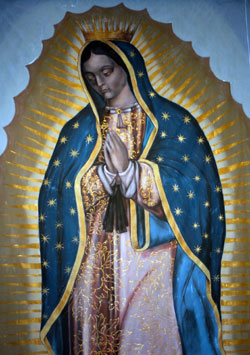Official Website of the
Catholic Diocese of Little Rock
Key Marian feasts to offer spiritual insight
Published: December 5, 2016
Contact Your Parish for Mass Times
The solemnity of the Immaculate Conception is Thursday, Dec. 8. It is a holy day of obligation to attend Mass.
Two important Marian feasts are celebrated during Advent. The solemnity of the Immaculate Conception of the Blessed Virgin Mary will be celebrated Thursday, Dec. 8. It is a holy day of obligation to attend Mass. To find holy day Mass times in your area, contact a parish near you. The feast of Our Lady of Guadalupe will be celebrated on Monday, Dec. 12. Special celebrations mark this feast in parishes across Arkansas. See our Calendar of Events to find events in your area.
Immaculate Conception — Dec. 8
Although we celebrate the Immaculate Conception during Advent, the season during which we prepare for the birth of Jesus, this feast is NOT about the conception of Jesus. This can be confusing because the Gospel reading for this holy day focuses on the angel Gabriel appearing to Mary. "The angel said to her, 'Do not be afraid, Mary, for you have found favor with God. Behold, you will conceive in your womb and bear a son, and you shall name him Jesus.'" (Luke 1:30-31)
The Immaculate Conception refers to the conception of Mary, the mother of Jesus. The "immaculate" is not a reference to how she was conceived by her parents, Sts. Joachim and Anne. It acknowledges that God intervened and allowed her to be conceived without the stain of original sin.
So why does the Church use the announcement of Jesus' birth as the Gospel for this feast day? Before Gabriel tells Mary that she has been chosen to be the mother of Jesus, he greets her: “'Hail, full of grace! The Lord is with you.' But she was greatly troubled at what was said and pondered what sort of greeting this might be. Then the angel said to her, 'Do not be afraid, Mary, for you have found favor with God." (Luke 1:28-30)
The Catechism of the Catholic Church explains the significance of this greeting. "To become the mother of the Savior, Mary 'was enriched by God with gifts appropriate to such a role.' The angel Gabriel at the moment of the annunciation salutes her as 'full of grace.' In fact, in order for Mary to be able to give the free assent of her faith to the announcement of her vocation, it was necessary that she be wholly borne by God's grace. Through the centuries the Church has become ever more aware that Mary, 'full of grace' through God, was redeemed from the moment of her conception.
"That is what the dogma of the Immaculate Conception confesses, as Pope Pius IX proclaimed in 1854: 'The most Blessed Virgin Mary was, from the first moment of her conception, by a singular grace and privilege of almighty God and by virtue of the merits of Jesus Christ, Savior of the human race, preserved immune from all stain of original sin.'" (nos. 490-491. See also, nos. 721-726)
Our Lady of Guadalupe — Dec. 12
 In December 1531, the Blessed Virgin Mary appeared as an Aztec princess to Juan Diego on the hill of Tepeyac, outside a small village near Mexico City. The poor, humble man, who was declared a saint in 2002, told his bishop about the visits from the Virgin of Guadalupe and her desire for a church to be built on the site where she appeared. The bishop asked for a sign to prove that Juan Diego was telling the truth.
In December 1531, the Blessed Virgin Mary appeared as an Aztec princess to Juan Diego on the hill of Tepeyac, outside a small village near Mexico City. The poor, humble man, who was declared a saint in 2002, told his bishop about the visits from the Virgin of Guadalupe and her desire for a church to be built on the site where she appeared. The bishop asked for a sign to prove that Juan Diego was telling the truth.
When Juan Diego asked Mary to provide this proof, she told him to gather the roses growing on the hillside. Even though roses are rare in December, he was able to fill his cloak with them. When he returned to the bishop, he opened his cloak the fresh roses fell to the ground and miraculously revealed an imprint of Our Lady’s image on his tilma (cloak).
The bishop fell to his knees and agreed to build a church on the site. The Catholic Church approved the apparition in 1555. Our Lady of Guadalupe was solemnly crowned Queen of the Mexican people in the name of Pope Leo XIII in 1895. As a result, millions converted to Christianity in Mexico. Today, Our Lady of Guadalupe is not only the patroness of Mexico, but of all the Americas. The Basilica of Our Lady of Guadalupe is now located on the site where she appeared.
Miraculously, the 485-year-old tilma that held Our Lady of Guadalupe's image remains to this day. According to the International Marian Research Institute, it has survived 17th-century floods in Mexico City and was undamaged by a bomb explosion. The colors have not faded over time and the cactus cloth remains intact although such material typically lasts fewer than 20 years. Rich with symbolism, the image itself reveals part of the message Our Lady came to give the people of Mexico.
In addition to Masses, processions and novenas to celebrate Our Lady of Guadalupe, the U.S. Conference of Catholic Bishops asks Catholics to take part in a nationwide day of prayer for refugees and migrants on this feast day. Download the prayer book to learn more.










